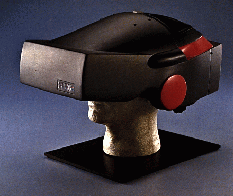 Figure 1
Figure 1
There
are different types of VR systems that exist today. Each VR
system consists of
hardware and software. Let us look at the most
common system--immersive
system. A typical immersive system employs head-mounted
display (HMD). HMD looks like a motorcycle helmet
(See Figure 1).
There are two lenses inside through which the user sees
the screen.
The computer projects two images on the screen, and the
brain fuses them into
one 3D image. A tracking device continuously
measures head?s movements,
and a computer constantly updates the
current view.
However, HMDs are quite heavy, so the Binocular Omni
Orientation Monitor
(BOOM) has been designed.3
 Figure 1
Figure 1
The BOOM resembles periscope (See Figure 2). Look inside two
eyeglasses, and you
will be not above the water, but inside the virtual
environment.
The optical system of the BOOM is inside the box which is
attached to a rotating
arm. To look around, just move the box to any
position. Control
buttons are used as interface devices (we will discuss it
in the following pages).3
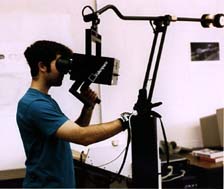 Figure 2
Figure 2
"In the CAVE, you are no longer on the outside looking in but on
the inside looking
out," said Thomas DeFanti, co-developer of the CAVE
at the University
of Illinois at Chicago. CAVE (Cave Automatic Virtual
Environment) is one
of the newest immersive systems. The immersion is
accomplished by projecting
stereoscopic images on the walls and floor of
a cube, which has
dimensions of a room (See Figure 3). Users wear
stereo glasses and
enter the CAVE, where they can freely walk and
interact with each
other as well as with objects. A tracker is attached to
the glasses, and the
computer continuously regenerates images to the
current view with
respect to the viewer with the tracking device. CAVE
system is beneficial
for collaborative work, and also is advantageous over
above-mentioned environments:
free movements, light glasses, and larger
view field.
Moreover, soon it will be quite possible for CAVE-to CAVE
communications to
be very common as the bandwidth of communications
channels will increase.3
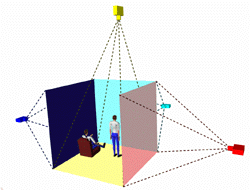 Figure 3
Figure 3
How does the user interact with the objects? This is another
technical aspect of
VR. There is a variety of interface devices that are
used to navigate through
the VR and interact with the simulated objects.
These devices form
a connection between the user and computer.
One of these devices is a dataglove (See Figure 4). With the
dataglove the user
can signal commands to the computer. The
gestures of datagloves
trigger pre-programmed commands and make
the computer respond
and change the modes. Some datagloves use
fiber optic cables,
and change in the amount of light signals the
computer how fingers
are bent, and in turn stimulate the necessary
response. Other
types of datagloves utilize strain sensors over the joints
of fingers in order
to observe the movements. Others employ
mechanical sensors.4
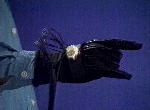 Figure 4
Figure 4
Another type of input devices is wands. Wands are
of different shapes
and variations, which depend on device's usage.
Wands have knobs,
or joysticks, and they operate with six degrees of
freedom. Moreover,
wands are quite popular because they are simple and
flexible in usage.
Other interface devices are stairsteppers (See Figure 5),
or anything that can
be utilized into sensing device, as Caterpillar, Inc.
used tractor cab with
attached sensors to simulate test drives.4
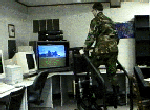 Figure 5
Figure 5
However, systems and interface devices are not enough to
experience the virtual
world as the real one. To enhance the virtual
environment, sound,
tactile and force devices, and voice recognition are
implemented.
There are also VR technologies that are not completely
immersive. The
development of VRML (Virtual Reality Modeling
Language) makes it
possible for 3D world on WWW. Via
browsers, graphics
monitor and mouse control, it is possible to view
VRML archetypes on
the web. Moreover, VRML's structure allows for
the transfer of models
into immersive systems. Nowadays, VRML is
undergoing development,
which will enhance the representation of virtual
environments.
Another system is Augmented Reality, which allows the
user to see a virtual
3D model superimposed on the real world view.
Augmented Reality
system is usually equipped with the video-see-through
display (See Figure
6).5 Telepresence system allows the
user in the real
world, while at the
distant location, to interact with the real objects via
robot arms.
NASA is going to use telerobotics in its space exploration
programs, and moreover,
today the study of telepresence system for
space rover exploration
is undertaken by US-Russian project.6
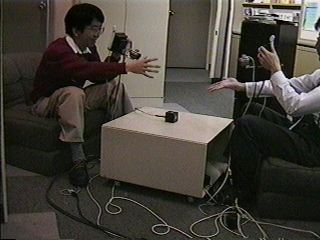
Figure 6
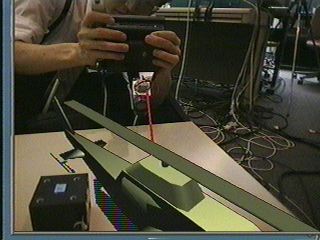
We realize that there are quite a lot of applications made
possible by evolving
VR technology. However, before proceeding to VR
applications, let
us see how VR has developed.